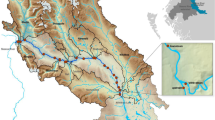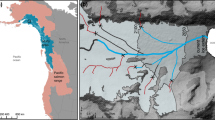Abstract
The Nooksack Indian Tribe (Tribe) inhabits the area around Deming, Washington, in the northwest corner of the state. The Tribe is dependent on various species of Pacific salmonids that inhabit the Nooksack River for ceremonial, commercial, and subsistence purposes. Of particular importance to the Tribe are spring Chinook salmon. Since European arrival, the numbers of fish that return to spawn have greatly diminished because of substantial loss of habitat primarily due to human-caused alteration of the watershed. Although direct counts are not available, it is estimated that native salmonid runs are less than 8 % of the runs in the late 1800’s. In addition, climate change has caused and will continue to cause an increase in winter flows, earlier snowmelt, decrease in summer baseflows, and an increase in water temperatures that exceed the tolerance levels, and in some cases lethal levels, of several Pacific salmonid species. The headwaters of the Nooksack River originate from glaciers on Mount Baker that have experienced significant changes over the last century due to climate change. Melt from the glaciers is a major source of runoff during the low-flow critical summer season, and climate change will have a direct effect on the magnitude and timing of stream flow in the Nooksack River. Understanding these changes is necessary to protect the Pacific salmonid species from the harmful effects of climate change. All nine salmonid species that inhabit the Nooksack River will be adversely affected by reduced summer flows and increased temperatures. The most important task ahead is the planning for, and implementation of, habitat restoration prior to climate change becoming more threatening to the survival of these important fish species. The Tribe has been collaboratively working with government agencies and scientists on the effects of climate change on the hydrology of the Nooksack River. The extinction of salmonids from the Nooksack River is unacceptable to the Tribe since it is dependent on these species and the Tribe is place-based and cannot relocate to areas where salmon will survive.


Similar content being viewed by others
References
Bach AJ (2002) Snowshed contributions to the Nooksack River watershed, North Cascades range, Washington. Geogr Rev 92(2):192–212
Beechie T, Imaki H, Greene J, Wade A, Wu H, Pess G, Roni P, Kimball J, Stanford J, Kiffney P, Mantua N (2012) Restoring salmon habitat for a changing climate. River Res Appl. doi:10.1002/rra.2590
Casola JH, Cuo L, Livneh B, Lettenmaier DP, Stoelinga MT, Mote PW, Wallace JM (2009) Assessing the impacts of global warming on snowpack in the Washington Cascades. J Clim 22:2758–2772
Coe T (2001) Nooksack River Watershed Riparian Function Assessment. Natural Resources Department, Nooksack Indian Tribe
Colombi B (2009) Salmon Nation: Climate Change and Tribal Sovereignty. Chapter 9, Anthropology and Climate Change. Edt. Crate and Nuttall, Left Coast Press
Currence N (2013) Personal communication with O. Grah, Water Resources Program Manager, Nooksack Indian Tribe. Fisheries/Resource Protection Manager, Nooksack Indian Tribe
Dickerson S, and Mitchell R (2012) (in review). Modeling the effects of climate change projections on streamflow in the Nooksack River basin, northwest Washington. Hydrological Processes
Dittmer K (2013) Changing streamflow on Columbia basin tribal lands- climate change and salmon. Climate Change. doi:10.1007/s10584-013-0745-0
Elsner MM, Cuo L, Voisin N, Deems J, Hamlet AF, Vano JA, Mickelson KEB, Lee SY, Lettenmaier DP (2010) Implications of 21st century climate change for the hydrology of Washington State. Clim Chang 102(1–2):225–260
Granshaw FD, Fountain AG (2006) Glacier change (1958–1998) in the North Cascades National Park Complex, Washington, USA. J Glaciol 52(177):251–256
Hamlet AF, Lettenmaier DP (2007) Effects of climate change on hydrology and water resources in the Columbia River basin. J Am Water Resour Assoc (JAWRA) 35(6):1597–1623
Hamlet AF, Mote PW, Martyn PC, Lettenmaier DP (2005) Effects of temperature and precipitation variability on snowpack trends in the western United States. J Clim 18:4545–4561
Harper JT (1993) Glacier Terminus Fluctuations on Mount Baker, Washington, USA, 1940–1990, and Climatic Variations. Arct Alp Res 25(4):332–340
Hoffman MJ, Fountain AG, Achuff JM (2007) 20th-century variations in area of cirque glaciers and glacierets, Rocky Mountain National Park, Colorado, USA. Ann Glaciol 46:349–354
Isaak DJ, Wollrab S, Horan D, Chandler G (2011) Climate change effects on stream and river temperatures across the northwest U.S. from 1980–2009 and implications for salmonid fishes. Clim Chang. doi:10.1007/s10584-011-0326-z
Kaser G, Osmaston HA (2002) Tropical glaciers. Cambridge University Press, Cambridge
Klein S, Butcher J, Duncan B, Herron H (2013) EPA region 10 climate change and TMDL pilot project research plan. U.S. Environmental Protection Agency, Office of Research and Development, Corvallis, OR. EPA/600/R/13/028
Lackey R (2000) Restoring wild salmon to the Pacific Northwest: Chasing an illusion? In: Koss P, Katz M (eds) In: What We Don’t Know about Pacific Northwest Fish Runs --- An Inquiry into Decision-Making. Portland State University, Portland, pp 91–143, http://www.epa.gov/wed/pages/staff/lackey/pubs/illusion.htm
Mantua NJ, Tohver I, Hamlet AF (2010) Climate change impacts on streamflow extremes and summertime stream temperature and their possible consequences for freshwater salmon habitat in Washington State. Clim Chang 102(1–2):187–223
Minder JR (2010) The sensitivity of mountain snowpack accumulation to climate warming. J Clim 23:2634–2650
Mitchell R (2013) Personal communication with O. Grah, Water Resources Program Manager, Nooksack Indian Tribe. Professor of Geology, Western Washington University, Bellingham, WA
Mote PW (2003) Trends in temperature and precipitation in the Pacific Northwest during the twentieth century. Northwest Sci 77(4):271–282
Mote PW, Salathé EP (2010) Future climate in the Pacific Northwest. Clim Chang 102(1–2):29–50
Mote PW, Hamlet AF, Clark M, Lettenmaier DP (2005) Declining mountain snowpack in western North America. Bull Am Meteorol Soc 86(1):39–49
Mote PW, Petersen A, Reeder S, Shipman H and Whitely-Binder L (2008) Sea level rise in the coastal waters of Washington State. A report by the University of Washington Climate Impacts Group and the Washington Department of Oceanography
National Parks Service (NPS) (2012) http://www.nps.gov/noca/naturescience/glacial-mass-balance1.htm
Natural Resources Conservation Service (NRCS) (2012) http://www.wcc.nrcs.usda.gov/snow/
Nolin AW, Phillippe J, Jefferson A, Lewis SL (2010) Present-day and future contributions of glacier runoff to summertime flows in a Pacific Northwest watershed: implications for water resources. Water Resour Res 46:W12509
NIT (Nooksack Indian Tribe) (2012) Nooksack River Watershed Water temperature Monitoring Program 2010 and 2011. Natural Resources Department, Nooksack Indian Tribe
Office of the Washington State Climatologist (OWSC) (2012) http://www.climate.washington.edu
Pelto MS (2006) The current disequilibrium of North Cascade glaciers. Hydrol Process 20. doi:10.1002/hyp.6132
Pelto MS (2008) Impact of climate change on North Cascade alpine glaciers and alpine runoff. Northwest Sci 82(1):65–75
Pelto MS (2010) Forecasting temperate alpine glacier survival from accumulation zone observations. Cryosphere 3:323–350
Pelto MS (2011) Skykomish River, Washington: Impact of ongoing glacier retreat on streamflow. Hydrol Process 25(21):i–ii, 3267–3371
Pelto MS, Brown C (2012) Mass balance loss of Mount Baker, Washington glaciers 1990–2010. Hydrol Process 26(17):2601–2607
Poole G, Dunham J, Hicks M, Keenan D, Lockwood J, Matema E, McCullough D, Mebane C, Risley J, Sauter S, Spalding S, Sturdevant D (2001) Technical Synthesis: Scientific issues relating to temperature criteria for salmon, trout, and char native to the Pacific Northwest. U.S. Environmental Protection Agency, Seattle
Post AP, Richardson D, Tangborn WV, and Rosselot FL (1971) Inventory of glaciers in the North Cascades, Washington, U.S. Geol Surv Prof Pap 705 (A)
Riedel J and Larrabee MA (2011) North Cascades National Park Complex glacier mass balance monitoring annual report, Water year 2009: North Coast and Cascades Network. Natural Resource Technical Report NPS/NCCN/NRTR—2011/483. National Park Service, Fort Collins, Colorado
Rosenberg EA, Keys PW, Booth DB, Hartley D, Burkey J, Steinemann AC, Lettenmaier DP (2010) Precipitation extremes and the impacts of climate change on stormwater infrastructure in Washington State. Clim Chang 102(1-2):319–349
Salathe EP (2006) Influences of a shift in north pacific storm tracks on western North American Precipitation under global warming. Geophys Res Lett 33:L19820
Salathe EP, Leung LR, Qian Y, Zhang Y (2010) Regional climate model projections for the State of Washington. Clim Chang 102(1–2):51–75
Stewart IT (2009) Changes in snowpack and snowmelt runoff for key mountain regions. Hydrol Process 23(1):78–94
Tebaldi C, Hayhoe K, Arblaster JM, Meehl GA (2006) Going to the extremes: an intercomparison of model-simulated historical and future changes in extreme events. Clim Chang 79:185–211
The Climate Impacts Group (2013) http://warm.atmos.washington.edu/2860/products/sites/?site=6022
Washington State Department of Fish and Wildlife (WDFW) (2002) Salmonid Stock Inventory. Olympia, WA. http://wdfw.wa.gov/fish/sasi/
Washington Technical Advisory Group Built Infrastructure Report (WTAGBI) (2010) http://www.ecy.wa.gov/climatechange/2010TAG.htm
Water Resources Inventory Area 1 (WRIA1) (2005) WRIA1 Salmonid Recovery Plan. WRIA1 Salmon Recovery Board and Whatcom County Public Works
WRIA1 Watershed Management Project (2000) Weighted Useable Area Documentation for WRIA1. WRIA1 Salmon Recovery Board and Whatcom County Public Works
Author information
Authors and Affiliations
Corresponding author
Additional information
This article is part of a Special Issue on “Climate Change and Indigenous Peoples in the United States: Impacts, Experiences, and Actions” edited by Julie Koppel Maldonado, Rajul E. Pandya, and Benedict J. Colombi.
Rights and permissions
About this article
Cite this article
Grah, O., Beaulieu, J. The effect of climate change on glacier ablation and baseflow support in the Nooksack River basin and implications on Pacific salmonid species protection and recovery. Climatic Change 120, 657–670 (2013). https://doi.org/10.1007/s10584-013-0747-y
Received:
Accepted:
Published:
Issue Date:
DOI: https://doi.org/10.1007/s10584-013-0747-y




